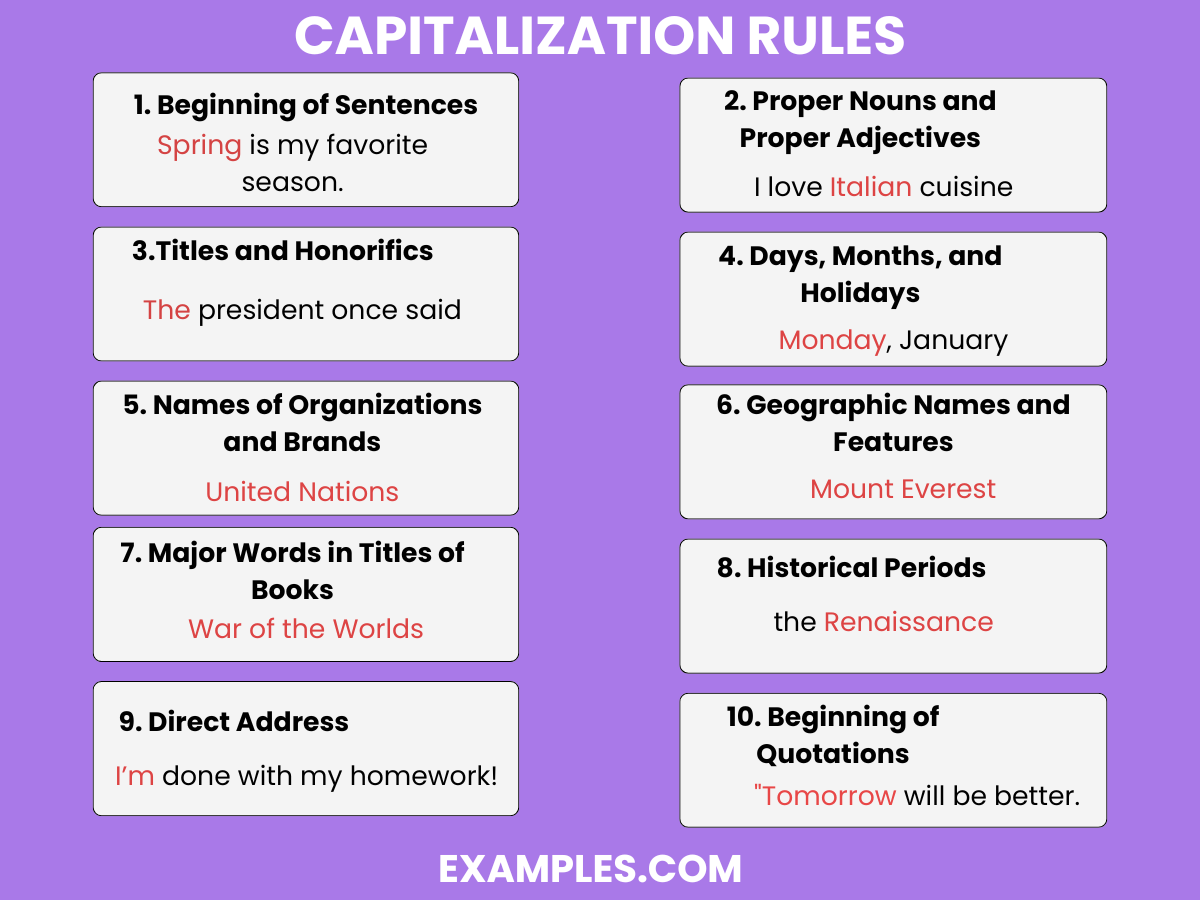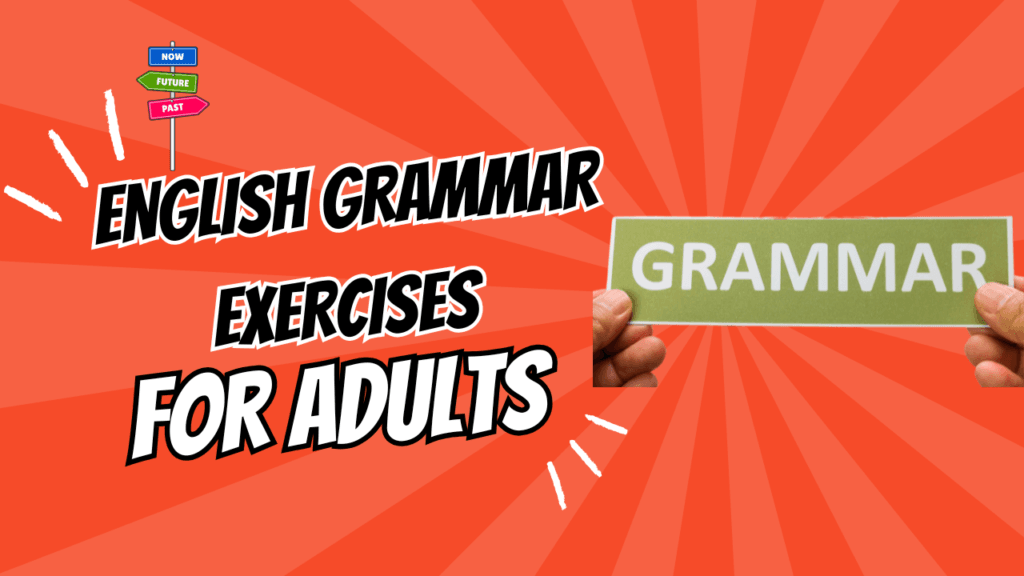Simple grammar rules might feel overwhelming as you try to communicate clearly in writing. Your Facebook status updates may flow naturally, but formal writing follows stricter conventions that are harder to learn. Many people feel anxious about using proper grammar.
Basic grammar rules are among the toughest parts of learning a language. A tiny grammatical error can change the entire meaning of your message. Professional writing just needs you to pay attention to core rules that build your credibility and clarity, unlike casual conversations.
Serious writers definitely need these grammar fundamentals. This detailed guide shows 12 key grammar rules that will improve your communication skills. It also provides practical grammar examples to help you use these concepts right away and avoid mistakes that hurt your writing quality.
Start Sentences with Capital Letters

Image Source: Examples.com
Capitalizing the first letter of every sentence is one of the simplest grammar rules in English writing. This small detail affects how readers notice your writing quality and attention to detail by a lot.
Start Sentences with Capital Letters – Definition
Capital letters at the start of sentences show readers that a new thought or idea begins. This basic rule applies to all sentences – whether they start a paragraph, follow a period, or appear after a colon that introduces a complete sentence. The first word of a direct quote that forms a complete sentence needs capitalization too.
You need to capitalize these three things in English:
- The first word of every sentence
- The pronoun “I”
- Proper nouns (names of specific people, places, organizations)
Start Sentences with Capital Letters – Common Mistakes
Many writers still make capitalization errors even though the rule is straightforward. Here are common mistakes you might see:
- Missing capitalization in casual writing – People often skip capitals at the start of sentences because of texting habits
- Forgetting to capitalize “I” – Students often miss capitalizing the pronoun “I” in their writing
- Over-capitalization – People capitalize words unnecessarily, usually because they don’t know proper nouns or trust automatic grammar checkers too much
All the same, these errors can leave readers with a bad impression. Good capitalization shows you know writing conventions and care about presenting ideas professionally.
Start Sentences with Capital Letters – Grammar Examples
Understanding correct and incorrect examples helps you remember this grammar rule better:
Incorrect: it is easy to take care of turtles. the house on the corner is for sale.
Correct: It is easy to take care of turtles. The house on the corner is for sale.
Quote rules change based on how you use them:
Complete sentence quote: Emerson once said, “A foolish consistency is the hobgoblin of little minds.”
Fragment quote: She referred to him as “a plague sore.”
You should avoid writing full sentences or paragraphs in all capitals because they’re hard to read. Good capitalization helps readers understand your writing quickly and easily.
Use Subject-Verb-Object Order
Image Source: the free encyclopedia
English follows a strict word order that creates the foundations of clear communication. The subject-verb-object (SVO) structure shows the simple arrangement of elements in English sentences. This represents one of the most essential grammar rules you need to become skilled at.
Use Subject-Verb-Object Order – Definition
A sentence needs the subject first, verb second, and object third. This pattern serves as the backbone of English sentence construction and we call it the canonical word order. English belongs to languages that use SVO structure, which makes up much of the world’s languages. SVO and SOV (subject-object-verb) patterns account for more than 87% of languages globally.
These components serve specific functions:
- Subject – The person or thing performing the action (typically answers “who?” or “what?”)
- Verb – The action being performed
- Object – The person or thing receiving the action (typically answers “whom?” or “what?”)
To name just one example, see “Andy ate cereal.” Here, “Andy” is the subject, “ate” is the verb, and “cereal” is the object.
Use Subject-Verb-Object Order – Common Mistakes
Word order challenges many writers, especially those who speak languages with different patterns. Here are the biggest problems:
- Misplacing adverbs – Writers position adverbs incorrectly between subject and verb or after the subject (“I very well know Manchester” instead of “I know Manchester very well”)
- Using other language patterns – Writers apply SOV patterns from their native languages (“Jenny cake eats” instead of “Jenny eats cake”)
- Incorrect question formation – Writers fail to invert subject and verb or auxiliary verb in questions
- Passive voice confusion – Writers mistake passive voice structure (which doesn’t follow SVO) for active voice
If you haven’t already, have a look at our fun article about English grammar exercises to practice for adults.

Use Subject-Verb-Object Order – Grammar Examples
SVO patterns stay consistent across all tenses:
Present tense: “May designs cars.” Past tense: “Petra stroked the dog.” Future tense: “The teacher will read a story.”
English generally follows SVO structure, but you’ll find some variations:
- Questions: “Who did you see?” (object-subject-verb)
- Emphasis: “Sewing I hate, but I’ll sew that for you.” (object-subject-verb)
- Passive voice: “The cake was eaten by Jenny.” (transforms from “Jenny ate the cake”)
Proper word order plays a vital role because English relies on this structure instead of extensive case markings to show relationships between words. Wrong word order can change your sentence’s meaning or make it impossible to understand.
Ensure Subject-Verb Agreement
Image Source: Grammarly
Subject-verb agreement is the life-blood of grammatical accuracy in English writing. Your sentences fall apart when subjects and verbs don’t match in number. This mismatch confuses readers and makes them question your writing abilities.
Ensure Subject-Verb Agreement – Definition
A sentence’s subject and verb must match in number—both need to be singular, or both need to be plural. This simple rule will give a grammatically correct and clear piece of writing. To cite an instance, singular subjects pair with singular verbs, while plural subjects need plural verbs.
The rule sounds simple: match singular subjects with singular verbs and plural subjects with plural verbs. The rule gets complicated in certain contexts, especially when you have present-tense sentences where verb forms change based on subject number.
Ensure Subject-Verb Agreement – Common Mistakes
Writers at all levels struggle with these common subject-verb agreement pitfalls:
- Prepositional phrase confusion: Words between the subject and verb can mislead you. The subject “box” (singular) drives the verb in “The box of chocolates is on the table,” not “chocolates.”
- Collective nouns: Words like “team,” “family,” and “committee” usually take singular verbs in American English. Example: “The committee decides on policy changes.”
- Indefinite pronouns: “Everybody,” “anyone,” and “each” need singular verbs, while “both,” “few,” and “many” take plural verbs.
- Compound subjects: Subjects joined by “and” need plural verbs. Subjects connected by “or” or “nor” agree with the closest subject. Example: “Either my sisters or my brother is picking me up.”
- Inverted subjects: Agreement errors often occur when the verb comes before the subject. The subject “plates” (plural) determines agreement in “There are seven plates on the table,” not “there.”
Ensure Subject-Verb Agreement – Grammar Examples
Let’s get into these examples to become skilled at subject-verb agreement:
Singular subjects with singular verbs:
- “My dog waits for the mail carrier.”
- “The secretary, together with the treasurer, just needs a revote.”
Plural subjects with plural verbs:
- “The cats meow at the door.”
- “Both are qualified for the job.”
Tricky situations:
- Mixed subjects with “or/nor”: “Either the employees or the manager is responsible.” (Agreement matches closest subject)
- Collective nouns: “The jury has reached a verdict.” (Treated as singular)
- Inverted order: “Over the rainbow flies a bird.” (Subject is “bird”)
Yes, it is true that becoming proficient in subject-verb agreement takes practice. Your writing gains precision and professionalism as you apply these simple grammar rules consistently. Your message becomes clearer and your writer’s credibility grows stronger.
Use Correct Verb Tenses
Image Source: Etsy
Mastering verb tenses is crucial to write well. You need to understand how actions occur in time to communicate clearly and maintain your reader’s trust.
Use Correct Verb Tenses – Definition
Verb tenses show when actions happen in time. English has three main tenses – past, present, and future – each showing different timeframes for actions. These tenses combine with four main aspects – simple, perfect, continuous (also called progressive), and perfect continuous – which create twelve possible combinations.
Simple aspect shows straightforward actions without duration emphasis. Perfect aspect (formed with “have”) links actions between time periods. Continuous aspect (formed with “be” + -ing) shows ongoing actions. Perfect continuous brings together both perfect and continuous aspects.
Academic writing relies heavily on present simple, past simple, and present perfect tenses.
Use Correct Verb Tenses – Common Mistakes
Writers struggle most with tense consistency. Random tense changes can leave readers confused:
❌ Incorrect: “The crowd claps and laughed at the comedian.” ✅ Correct: “The crowd clapped and laughed at the comedian.”
Here are other frequent errors:
- Unnecessary shifts – Random switches between past and present
- Overusing continuous tenses – Too many -ing forms make writing awkward
- Irregular verb confusion – Using “buyed” instead of “bought” or “costed” instead of “cost”
- Improper flashback handling – Not using past perfect for earlier past events
Use Correct Verb Tenses – Grammar Examples
Simple Present (for facts, general truths): “Water boils at 100°C.”
Simple Past (completed actions): “She finished her homework yesterday.”
Present Perfect (past actions with present relevance): “I have lived in Paris for five years.” (I still live there)
Past Perfect (actions completed before another past action): “By the time he arrived, they had already left.”
We used one main tense for our narrative and changed tenses only to show time differences:
“I sit on my grandmother’s white couch, listening to her talk about her wedding day. I suddenly remember a memory from childhood: a winter afternoon when I spilled hot cocoa on this very couch.”
Consistent verb tense helps readers follow your writing easily and understand how events connect in time.
Differentiate Adjectives and Adverbs
Image Source: YouTube
Using adjectives instead of adverbs is a common grammatical mistake in English writing. Your writing can transform from amateur to professional level when you know how to use each one correctly.
How to Distinguish Between Adjectives and Adverbs – Definition
Adjectives and adverbs serve as two distinct parts of speech with different grammatical functions:
Adjectives modify nouns and pronouns by answering questions like “what kind?” or “which?” or “how many?” They describe qualities, quantity, or state of being for people, places, things, or ideas.
Adverbs modify verbs, adjectives, or other adverbs and answer questions about:
- How? (manner)
- When? (time)
- Where? (place)
- Why? (reason)
- To what extent? (degree)
The main difference lies in what they modify—adjectives describe things, while adverbs describe actions or other descriptive words.
How to Distinguish Between Adjectives and Adverbs – Common Mistakes
Writers often make these mistakes with these parts of speech:
- Using adjectives instead of adverbs: “He speaks quick” instead of “He speaks quickly”
- Using adverbs instead of adjectives after linking verbs: “She feels badly” instead of “She feels bad” (after sense verbs like feel, taste, smell, sound, and look)
- Confusing good/well: “Good” is an adjective while “well” is typically an adverb
- Mishandling -ly endings: Not all adverbs end in -ly (fast, hard), and some adjectives do end in -ly (friendly, lonely)
- Double negatives: Using “scarcely no” or “hardly no one” instead of the correct “scarcely any” or “hardly anyone”
How to Distinguish Between Adjectives and Adverbs – Grammar Examples
These pairs demonstrate the difference in function:
“The dog smells clean.” (adjective describing the dog) “The dog smells carefully.” (adverb describing how the dog performs the action)
“She seems unhappy today.” (adjective modifying “she”) “She speaks unhappily about the news.” (adverb modifying “speaks”)
“He is a careful driver.” (adjective modifying “driver”) “He drives carefully.” (adverb modifying “drives”)
“This is a quick solution.” (adjective modifying “solution”) “She thinks quickly under pressure.” (adverb modifying “thinks”)
Sense verbs like feel, look, taste, smell, and sound typically take adjectives rather than adverbs when describing the subject. The difference between these two parts of speech improves your writing’s precision and professionalism significantly.
Use Articles Properly (a, an, the)
Image Source: Academic Guides – Walden University
Articles may look like small words, but becoming skilled at their proper usage is crucial to polish your grammar skills. These determiners create significant differences in meaning when they appear before nouns.
Use Articles Properly – Definition
Articles work as adjectives that specify whether a noun is definite or indefinite. English has three articles:
Definite article (the): Used when referring to a specific noun whose identity is known to both writer and reader. For example, “The dog that bit me ran away” refers to one particular dog.
Indefinite articles (a, an): Used with singular count nouns whose specific identity is unknown or to refer to any member of a group. Use a before consonant sounds (a book, a university) and an before vowel sounds (an apple, an hour).
Three main factors determine article choice:
- Whether the noun is countable or uncountable
- Whether the noun is singular or plural
- Whether the noun is definite or indefinite
Use Articles Properly – Common Mistakes
Writers at all levels can stumble with these common article errors:
- Using a/an with uncountable nouns: “I need a water” instead of “I need water”
- Placing a before vowel sounds: “a hour” instead of “an hour”
- Adding unnecessary articles before proper nouns: “The Oxford University” instead of “Oxford University”
- Omitting articles before singular countable nouns: “I bought book” instead of “I bought a book”
- Using the for general statements: “The apples are healthy” instead of “Apples are healthy”
Use Articles Properly – Grammar Examples
Indefinite articles (first mention): “I saw a dog yesterday. The dog was chasing a squirrel.”
No article (general statements): “Trees are beautiful in fall.” (all trees in general)
Specific reference: “Would you pass the salt?” (the specific salt on the table)
Special cases: “She’s at the bank.” (public place) “He studies biology.” (academic subject – no article)
Your grammar skills will improve as you practice these principles. To sum up, applying these rules consistently will lift your writing quality.
Avoid Double Negatives
Image Source: YouTube
Double negatives create logical paradoxes that often say the opposite of what you mean. Language should aim for clarity rather than follow mathematical rules where negative numbers multiply to create positives.
Avoid Double Negatives – Definition
A double negative occurs when two negative words appear in the same clause of a sentence. Standard English sees these two negatives cancel each other out and create a positive meaning that goes against the writer’s intention. To cite an instance, “I don’t have no money” actually means “I do have money”—the exact opposite of what people want to say.
Common negative words include:
- No, not, none, never, nowhere, nobody
- Negative adverbs like hardly, scarcely, barely
- Words with negative prefixes (un-, in-, non-)
Avoid Double Negatives – Common Mistakes
Writers make these double negative errors frequently:
- Using “can’t hardly” or “can’t scarcely” to describe something difficult
- Combining “not” with negative words like “nothing” or “no one”
- Using phrases like “cannot help but” instead of “cannot help” or “cannot but”
- Putting “never” with another negative (“We never see no kids playing outside”)
- Using “can’t barely” (which means “can”) instead of “can barely”
Double negatives sometimes appear on purpose in casual speech or certain dialects. Some languages need double negatives to be grammatically correct, which makes this rule especially challenging for non-native speakers.
Avoid Double Negatives – Grammar Examples
Let’s get into these corrections to understand proper usage:
Incorrect: “Al hadn’t but ten seconds to defuse the bomb.”
Correct: “Al had only ten seconds to defuse the bomb.”
Incorrect: “Charlie cannot see nothing without his glasses.”
Correct: “Charlie cannot see anything without his glasses.”
Incorrect: “She can’t go nowhere with that broken leg.”
Correct: “She can’t go anywhere with that broken leg.”
Context is a significant factor in interpreting subtle language choices. Some writers consider using double negatives to create understatement through litotes (like saying “not uncommon” instead of “common”).
Use Proper Punctuation
Image Source: Grammarly
Punctuation marks work like traffic signals in written language. They guide readers through your ideas with clarity and precision. Your brilliant thoughts can become jumbled and confusing without these signposts.
Use Proper Punctuation – Definition
Punctuation includes standardized marks in written text that clarify meaning and separate structural units. These marks work like body language in spoken communication and convey tone, emphasis, and relationships between ideas. Good punctuation shows readers where to pause, stop, or change direction in your writing.
The most common punctuation marks include:
- Periods (.) – End sentences and mark abbreviations
- Commas (,) – Indicate pauses and separate elements
- Question marks (?) – Denote interrogative statements
- Exclamation points (!) – Express emotion or emphasis
- Semicolons (;) – Connect related independent clauses
- Colons (:) – Introduce lists or explanations
- Apostrophes (‘) – Show possession or contraction
- Quotation marks (” “) – Indicate direct speech or quotes
Use Proper Punctuation – Common Mistakes
Skilled writers often struggle with these punctuation errors:
- Comma splices – Joining two independent clauses with only a comma
- Apostrophe misuse – Adding apostrophes to make words plural (“five dollar’s off”)
- Quotation mark misplacement – Placing periods outside quotation marks in American English
- Overusing exclamation points – More than one or two in an email appears unprofessional
- Semicolon confusion – Using them like commas or when a period would work better
Use Proper Punctuation – Grammar Examples
Let’s get into these corrections to improve your punctuation:
Comma use: “After the French Revolution had taken place, many countries were concerned about civil unrest.”
Semicolons: “Spanish is spoken throughout South America; in Brazil the main language is Portuguese.”
Quotation marks: “The fitness trainer said, ‘Don’t try to do too much when you begin.'”
Apostrophes: “The girl’s hat” (one girl) versus “The girls’ hat” (multiple girls)
Proper punctuation isn’t about being fussy—it’s about clarity. A $5 million lawsuit ended up hinging on a missing comma. So becoming skilled at these simple grammar rules doesn’t just make your writing look professional—it will give your message the exact interpretation you intended.
Understand Homophones
Image Source: YouTube
Homophones challenge even native speakers who want to master simple grammar rules in English writing. A single misused word can change your entire meaning.
Understand Homophones – Definition
Homophones are words that sound similar but have different meanings and often different spellings. The word originates from Greek roots: “homo” means “same” and “phone” means “sound”. “Hear” and “here” demonstrate this perfectly – they share pronunciation but differ in meaning. One refers to listening, while the other indicates location.
English has many homophone sets, and some words have three forms. Some words have as many as seven homophones – rays, raise, rase, raze, rehs, reis, and res.
Understand Homophones – Common Mistakes
Well-written content often suffers from these homophone errors:
- Your/You’re confusion: “Your” shows possession while “you’re” means “you are”
- There/Their/They’re mixups: “There” indicates location, “their” shows possession, and “they’re” is short for “they are”
- To/Too/Two trouble: “To” serves as a preposition or infinitive marker, “too” means “also” or “excessively,” and “two” is the number
- It’s/Its confusion: “It’s” is a contraction of “it is” while “its” shows possession
Writers rely on context to choose the correct word because homophones sound similar when spoken.
Understand Homophones – Grammar Examples
Context helps us pick the right homophone:
“Their house is beautiful. They’re going to the park. There is a cat on the porch.”
Common pairs that create confusion include:
- Accept/Except: “The organization will accept donations through the first of the month” versus “You may donate all but one of these items: car seats and cribs”
- Weather/Whether: “The constantly changing springtime weather is driving us crazy” versus “Please tell us whether you would prefer steak or salmon”
You become skilled at using homophones through awareness, understanding context, and practice with these tricky word pairs in your writing.
Use Conjunctions to Connect Ideas
Image Source: Grammarly
Conjunctions serve as the essential building blocks of language. They connect words, phrases, and clauses to create flowing and sophisticated sentences. Your writing would sound choppy and disconnected without these versatile connecting words.
Use Conjunctions to Connect Ideas – Definition
A conjunction connects other words, phrases, or clauses. The English language uses three main types of conjunctions:
Coordinating conjunctions connect elements of equal grammatical rank. Note that the acronym FANBOYS helps remember them: For, And, Nor, But, Or, Yet, So. These words link words, phrases, or independent clauses.
Subordinating conjunctions create dependent clauses and show relationships between ideas. Words like because, since, although, unless, until, and while fall into this category. They indicate cause-effect, time, condition, or contrast.
Correlative conjunctions appear in pairs to link balanced elements within a sentence. Common pairs include both/and, either/or, neither/nor, and not only/but also.
Use Conjunctions to Connect Ideas – Common Mistakes
Writers face these common conjunction challenges:
- Comma splices appear when independent clauses connect with just a comma instead of a coordinating conjunction
- Formal writing suffers from too many sentences starting with coordinating conjunctions
- Writers mix up conjunctive adverbs (however, therefore) with coordinating conjunctions
- Correlative conjunction pairs get mismatched (using “both X as well as Y” instead of “both X and Y”)
- “And” appears too often where specific conjunctions would better show relationships
- Unnecessary conjunctions stack together (“The teacher asked that why I was late”)
Use Conjunctions to Connect Ideas – Grammar Examples
Coordinating conjunctions: “I enjoy swimming, but I dislike running.”
Subordinating conjunctions: “Because it was raining, we canceled the picnic.”
Correlative conjunctions: “You can choose either the red shirt or the blue one.”
Punctuation rules matter with conjunctions. A comma should appear before coordinating conjunctions that join independent clauses. The comma disappears when joining just two words or phrases.
Form Questions Correctly
Image Source: Promova
The ability to ask questions properly shows a significant basic grammar skill that many writers find challenging. English questions have specific structural rules that are substantially different from statements. Writers need to pay attention to word order and verb forms.
Form Questions Correctly – Definition
English questions need subject-verb inversion or an auxiliary verb. The two main types are:
- Yes/No questions: These begin with an auxiliary or modal verb followed by the subject (auxiliary/modal + subject + main verb).
- “Are you ready?” (be verb)
- “Does he play football?” (using auxiliary “does”)
- Wh-questions: These start with question words (who, what, when, where, why, how) followed by an auxiliary verb and subject.
- “Where do you live?”
- “Why is she crying?”
Question formation depends on the main verb type. With “be” verbs, you simply invert the subject and verb. All other verbs need the appropriate form of “do” (do/does/did) and use the base form of the main verb.
Form Questions Correctly – Common Mistakes
Writers often make these errors in question formation:
- Adding auxiliary verbs with “be” verbs: “Do you are happy?” instead of “Are you happy?”
- Using the wrong main verb form after do/does/did: “Does she plays tennis?” instead of “Does she play tennis?”
- Not inverting subject and verb: “You are coming to the party?” instead of “Are you coming to the party?”
- Wrong word order in wh-questions: “What he drinks?” instead of “What does he drink?”
- Keeping the -s ending after “does”: “Does he works here?” instead of “Does he work here?”
Form Questions Correctly – Grammar Examples
Yes/No Questions with Be: “Is he angry?” (from “He is angry.”) “Are they from Mexico?” (from “They are from Mexico.”)
Yes/No Questions with Other Verbs: “Do you like spicy food?” (from “You like spicy food.”) “Did she study English last night?” (from “She studied English last night.”)
Wh-Questions: “Where did she go?” (from “She went somewhere.”) “How many books do you have?” (from “You have some books.”)
Subject Questions (no auxiliary needed): “Who broke the window?” (Subject is “who”) “What happened to your shirt?” (Subject is “what”)
Becoming skilled at forming questions will boost your writing and speaking abilities. You’ll communicate better in both formal and casual situations.
Use Apostrophes for Possession
Image Source: YouTube
Placing apostrophes to show possession is one of the most confusing simple grammar rules in English. This tiny punctuation mark adds crucial meaning to your writing when you use it correctly.
Use Apostrophes for Possession – Definition
We used apostrophes to show that one noun owns or possesses another. The rule for singular nouns is straightforward – add an apostrophe plus s (‘s) at the word’s end, even if the noun already ends in s. “The cat’s collar” or “James’s hat” show this rule in action. This applies whatever the singular noun’s ending sound might be.
Plural nouns that end in s need just an apostrophe after the s: “the girls’ excitement” or “the houses’ roofs.” But plural nouns that don’t end in s (irregular plurals) take both an apostrophe and s: “children’s shoes” or “mice’s breakfast.”
Use Apostrophes for Possession – Common Mistakes
Writers often make these apostrophe errors:
- Adding apostrophes to possessive pronouns – Never put apostrophes in its, hers, yours, ours, theirs, or his
- Mixing up its/it’s – “Its” shows possession while “it’s” means “it is” or “it has”
- Using apostrophes for plurals – “The Smith’s house” is wrong for multiple Smiths
- Getting joint possession wrong – Items owned together need an apostrophe only on the last noun: “Tom and Jerry’s ongoing rivalry”
Use Apostrophes for Possession – Grammar Examples
To name just one example, see how apostrophes work here:
Singular possessives: “The owner’s car” or “The boss’s chair”
Plural possessives: “The students’ demands” or “The Jeons’ garden”
Irregular plurals: “Women’s clothing” or “Geese’s eggs”
Compound possession: “My mother-in-law’s recipe” (single item) versus “The prosecutor’s and defendant’s speeches” (separate items)
Clear apostrophe usage improves your writing and shows you’ve mastered these simple English grammar rules.
Comparison Table
| Grammar Rule | Definition/Purpose | Key Components | Common Mistakes |
|---|---|---|---|
| Start Sentences with Capital Letters | Visual cue suggesting a new thought or idea | • First word of every sentence • Pronoun “I” • Proper nouns | • Missing capitals in casual writing • Forgetting to capitalize “I” • Over-capitalization |
| Use Subject-Verb-Object Order | Simple arrangement of elements in English sentences | • Subject (doer) • Verb (action) • Object (receiver) | • Misplacing adverbs • Using other language patterns • Incorrect question formation |
| Ensure Subject-Verb Agreement | Subject and verb must match in number | • Singular subjects with singular verbs • Plural subjects with plural verbs | • Prepositional phrase confusion • Collective noun errors • Indefinite pronoun mistakes |
| Use Correct Verb Tenses | Shows when actions occur in time | • Past, present, future tenses • Simple, perfect, continuous aspects | • Unnecessary tense shifts • Overusing continuous tenses • Irregular verb confusion |
| Distinguish Adjectives and Adverbs | Words that modify different parts of speech | • Adjectives modify nouns • Adverbs modify verbs, adjectives, other adverbs | • Using adjectives instead of adverbs • Confusing good/well • Mishandling -ly endings |
| Use Articles Properly | Specifies whether nouns are definite or indefinite | • Definite (the) • Indefinite (a, an) | • Using a/an with uncountable nouns • Misplacing articles with proper nouns • Wrong article before vowel sounds |
| Avoid Double Negatives | Prevents logical paradoxes in statements | • Negative words (no, not, never) • Negative adverbs • Negative prefixes | • Using “can’t hardly” • Combining “not” with negative words • Pairing “never” with negatives |
| Use Proper Punctuation | Guides readers through text with clarity | • Periods, commas, semicolons • Question marks • Apostrophes | • Comma splices • Apostrophe misuse • Quotation mark misplacement |
| Understand Homophones | Words that sound similar but have different meanings | • Sound-alike words • Different spellings • Different meanings | • Your/You’re confusion • There/Their/They’re mixups • It’s/Its confusion |
| Use Conjunctions to Connect Ideas | Links words, phrases, or clauses | • Coordinating conjunctions • Subordinating conjunctions • Correlative conjunctions | • Using comma splices • Mismatching correlative pairs • Overusing “and” |
| Form Questions Correctly | Creates proper interrogative statements | • Yes/No questions • Wh-questions • Subject-verb inversion | • Wrong auxiliary verb usage • Incorrect word order • Failing to invert subject-verb |
| Use Apostrophes for Possession | Shows ownership or possession | • Singular possession (‘s) • Plural possession (s’) • Joint possession | • Adding apostrophes to possessive pronouns • Confusing its/it’s • Using apostrophes for plurals |
Wrap Up
These 12 simple grammar rules will change your writing from amateur to professional. This piece teaches you the simple principles that are the foundations of clear communication. Each rule plays a vital role in conveying your message clearly and precisely – from proper capitalization to using apostrophes correctly.
Good grammar goes beyond just following rules. These conventions help readers understand your exact message. You remove barriers between your ideas and audience when you match subjects with verbs and use punctuation correctly.
Learning these rules needs practice, but the payoff is worth it. Your writing becomes clearer, your message appeals better, and your professional image grows stronger. Small details show your attention to detail and respect for readers – like knowing your homophones or keeping verb tenses consistent.
Grammar basics stay the same even as language changes. Time spent learning these 12 simple rules will help you throughout your writing career. These principles ensure your message arrives exactly as intended – whether you’re writing important emails, preparing reports, or posting on social media.
FAQs
Q1. What are the most important grammar rules to focus on for improving writing? The most crucial grammar rules include starting sentences with capital letters, using subject-verb-object order, ensuring subject-verb agreement, using correct verb tenses, and properly using punctuation. Mastering these fundamentals will significantly enhance your writing clarity and professionalism.
Q2. How can I avoid common mistakes when using apostrophes? To avoid apostrophe errors, remember to use them for possession (not plurals), add ‘s to singular nouns (even those ending in s), and use only an apostrophe after plural nouns ending in s. Also, don’t use apostrophes with possessive pronouns like its, hers, or theirs.
Q3. Why is it important to understand the difference between adjectives and adverbs? Understanding the distinction between adjectives and adverbs is crucial because they modify different parts of speech. Adjectives describe nouns, while adverbs modify verbs, adjectives, or other adverbs. Using them correctly enhances the precision and effectiveness of your writing.
Q4. What’s the best way to remember proper article usage? To use articles correctly, remember that ‘the’ is for specific nouns, while ‘a’ and ‘an’ are for non-specific singular nouns. Use ‘a’ before consonant sounds and ‘an’ before vowel sounds. Practice by reading extensively and paying attention to article usage in well-written texts.
Q5. How can I improve my question formation skills? To form questions correctly, practice inverting the subject and verb for yes/no questions, and use question words (who, what, when, where, why, how) followed by an auxiliary verb for wh-questions. Remember to use the base form of the main verb after ‘do/does/did’ in questions.

![12 Basic Grammar Rules to Write Like a Pro [2025 Guide]](https://englishlearninghub.online/wp-content/uploads/2025/07/12-Basic-Grammar-Rules-to-Write-Like-a-Pro-2025-Guide-1024x576.png)



